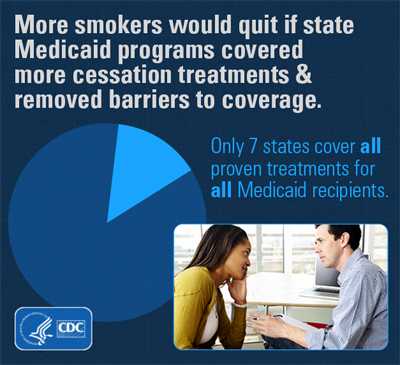Uneven progress in expanding state Medicaid coverage for smoking cessation
States make gradual progress, but few provide comprehensive coverage
This website is archived for historical purposes and is no longer being maintained or updated.
Press Release
Embargoed until: Thursday, March 27, 2014, 1:00pm ET
Contact: Media Relations
(404) 639-3286
More smokers would quit if state Medicaid programs covered more cessation treatments and removed barriers to coverage.
Entire infographic
More smokers would quit if state Medicaid programs covered more cessation treatments and removed barriers to coverage, according to a CDC study published in today’s Morbidity and Mortality Weekly Report. All 50 states and the District of Columbia cover cessation treatments for at least some Medicaid enrollees. Efforts to expand state Medicaid coverage for all smoking cessation treatments and the removal of coverage barriers have shown mixed progress over the past five years.
Americans enrolled in Medicaid are more likely to smoke than the general population, and smoking-related disease is a major contributor to increasing Medicaid costs. Insurance coverage of proven cessation treatments leads to more smokers using the treatments and successfully quitting smoking. A recent study from the American Journal of Preventive Medicine found that more comprehensive state Medicaid coverage was associated with increased quit rates among smokers enrolled in Medicaid.
Seven states cover all approved medications and in-person counseling cessation treatments for all Medicaid recipients. All states have some barriers to getting these treatments. The most common barriers are limits on how long treatment is covered and how much is covered per year; prior authorization requirements; and copayments.
"States can save lives and reduce costs by providing Medicaid coverage for all proven cessation treatments, removing barriers to accessing these treatments, and promoting the expanded coverage," said Tim McAfee, M.D., M.P.H., Director of the CDC’s Office on Smoking and Health. "Reducing the number of smokers will save lives and reduce health care costs."
The study compares 2008 with 2014 data and found that 41 states made changes to the treatments they covered for at least some plans or populations. Nineteen states added treatments to coverage without removing any treatments from coverage and eight states removed treatments from coverage without adding any treatments to coverage. Fourteen states both added and removed coverage.
During this same period, 38 states made changes to barriers to accessing treatments for at least some plans or populations. Nine states removed barriers without adding new barriers, 12 states added new barriers without removing existing ones, and 17 states both removed and added barriers.
"There’s evidence suggesting that smokers enrolled in Medicaid, like other smokers, want to quit and will take advantage of covered cessation treatments to help them quit for good," said Stephen Babb, M.P.H., co-author of the article.
Some of the strongest evidence comes from Massachusetts, which expanded its Medicaid cessation coverage in 2006.
"Massachusetts heavily promoted its new Medicaid cessation coverage to Medicaid enrollees and health care providers, and saw a drop in the smoking rate among Medicaid enrollees from 38 percent to 28 percent," said Babb. There was also an almost 50 percent drop in hospital admissions for heart attacks among those who used the benefit. It is important that all smokers who want help quitting, including smokers enrolled in Medicaid, have access to proven cessation treatments and services."
Fifty years after the first Surgeon General’s Report linking cigarette smoking to lung cancer, smoking remains the leading cause of preventable death and disease in the United States, killing nearly half a million Americans every year. More than 16 million Americans live with a smoking-related disease. Smoking-related diseases cost Americans $132 billion a year in direct health care expenses, much of which comes in taxpayer-supported payments. The most recent Surgeon General’s Report, released in January 2014, recommends providing barrier-free access to proven cessation treatments, and expanding cessation services for all smokers in primary and specialty care settings.
Through the Affordable Care Act, more Americans will qualify to get health care coverage that fits their needs and budget, including important preventive services such as certain services to quit smoking that may be covered with no additional costs. Visit Healthcare.gov or call 1-800-318-2596 (TTY/TDD 1-855-889-4325) to learn more.
- Page last reviewed: March 27, 2014 (archived document)
- Content source:
Error processing SSI file


 ShareCompartir
ShareCompartir
